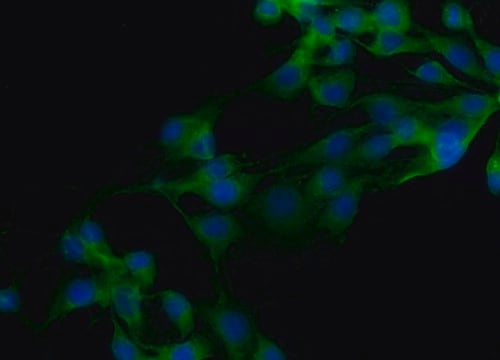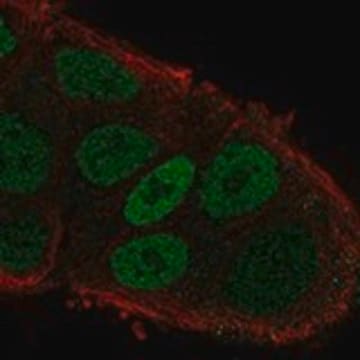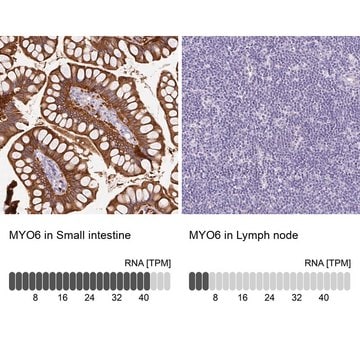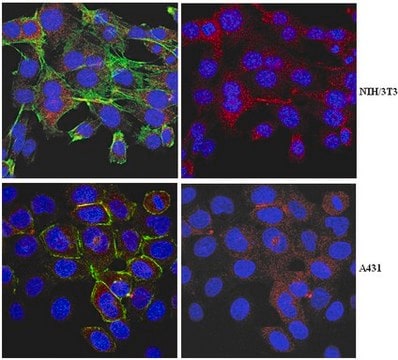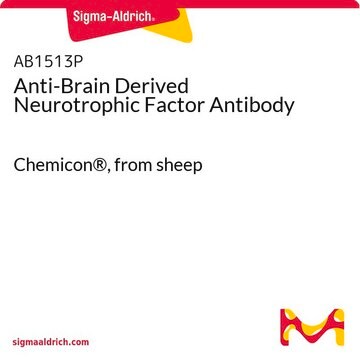推荐产品
生物源
mouse
品質等級
共軛
unconjugated
抗體表格
purified from hybridoma cell culture
抗體產品種類
primary antibodies
無性繁殖
MUD-19, monoclonal
形狀
buffered aqueous solution
分子量
antigen ~150 kDa by SDS-PAGE
物種活性
human, mouse, rat
濃度
~1 mg/mL
技術
immunohistochemistry: suitable
immunoprecipitation (IP): suitable
indirect ELISA: suitable
microarray: suitable
western blot: 2 μg/mL using A431 total cell extract
同型
IgG1
UniProt登錄號
運輸包裝
dry ice
儲存溫度
−20°C
目標翻譯後修改
unmodified
基因資訊
human ... MYO6(4646)
mouse ... Myo6(17920)
rat ... Myo6(315840)
一般說明
Monoclonal Anti-Myosin VI (mouse IgG1 isotype) is derived from the MUD-19 hybridoma produced by the fusion of mouse myeloma cells and splenocytes from mice immunized with a synthetic peptide corresponding to amino acids of human myosin VI. Myosin VI is a relatively abundant widespread unconventional myosin composed of an N-terminal motor domain, a light chain binding neck region, a coil-coiled region and a highly conserved C-terminal domain.
Myosins are actin-dependent motors that have 15 classes based on their phylogenetics . Myosin VI is an unconventional actin motor that moves towards the minus ends of actin filaments, which is opposite to the movement of conventional myosins.
特異性
Monoclonal Anti-Myosin VI antibody is specific for myosin VI in rats, humans and mice.
應用
Monoclonal Anti-Myosin VI antibody produced in mouse has been used in:
- enzyme-linked immunosorbent assay (ELISA)
- immunoprecipitation
- western blot assay
- immunohistochemistry
生化/生理作用
Myosin VI is involved in the generation of cell shape change, cell motility, membrane remodeling and possibly in organelle and particle transport or tethering. It is also involved in membrane trafficking pathways in cultured mammalian cells where it is associated with the membrane ruffles and the trans-Golgi network. Myosin VI plays an essential role in the development of the mouse inner ear where it is expressed in the hair cell body, in the actin-rich cuticular plate at the base of the stereocilia and in the peri cuticular necklace region. Myosin VI gene mutations are involved in deafness and balance defects in the Snell′s Waltzer mouse. Myosin VI is present in the Golgi complex and may regulate vesicular transport across the membranes.
外觀
Supplied as a solution in 0.01 M phosphate buffered saline, pH 7.4, containing 1% bovine serum albumin and 15 mM sodium azide.
免責聲明
Unless otherwise stated in our catalog or other company documentation accompanying the product(s), our products are intended for research use only and are not to be used for any other purpose, which includes but is not limited to, unauthorized commercial uses, in vitro diagnostic uses, ex vivo or in vivo therapeutic uses or any type of consumption or application to humans or animals.
Not finding the right product?
Try our 产品选型工具.
儲存類別代碼
10 - Combustible liquids
水污染物質分類(WGK)
WGK 3
閃點(°F)
Not applicable
閃點(°C)
Not applicable
Hala Nasser et al.
Journal of medical genetics, 57(6), 389-399 (2020-02-06)
Primary hereditary microcephaly (MCPH) comprises a large group of autosomal recessive disorders mainly affecting cortical development and resulting in a congenital impairment of brain growth. Despite the identification of >25 causal genes so far, it remains a challenge to distinguish
Myosin VI and its interacting protein LMTK2 regulate tubule formation and transport to the endocytic recycling compartment
Chibalina MV, et al.
Journal of Cell Science, 120(24), 4278-4288 (2007)
Zishu Wang et al.
Gene, 593(1), 100-109 (2016-08-16)
Myosin VI (MYO6) is a unique member of the myosin superfamily. Although it has been reported to participate in human cancer progression, the role of MYO6 in gastric cancer remains unclear. In this study, we found the expression of MYO6
MYO6 knockdown inhibits the growth and induces the apoptosis of prostate cancer cells by decreasing the phosphorylation of ERK1/2 and PRAS40
Wang D, et al.
Oncology Reports, 36(3), 1285-1292 (2016)
Francesca Demichelis et al.
Genes, chromosomes & cancer, 48(4), 366-380 (2009-01-22)
Emerging molecular and clinical data suggest that ETS fusion prostate cancer represents a distinct molecular subclass, driven most commonly by a hormonally regulated promoter and characterized by an aggressive natural history. The study of the genomic landscape of prostate cancer
我们的科学家团队拥有各种研究领域经验,包括生命科学、材料科学、化学合成、色谱、分析及许多其他领域.
联系技术服务部门